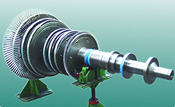OUR LOCATIONS
We can provide our services to power plants worldwide
Bradenton, Florida
941 - 527 - 6196
941 - 755 - 5229 (FAX)
Milwaukee, Wisconsin
414 - 698 - 5644
|

HIGH-SPEED SHOP BALANCING
High-speed balancing in the shop is an indispensible procedure following turbine or generator rotor service work. The goal, of course, is ultimately to assure that a rotor will smoothly run when returned to service at a plant, reducing the risk of lost production time spent resolving unanticipated high vibrations by field balancing. The risk/reward to perform high-speed balancing is in large part an economics issue, with the potential cost of lost production and field balancing in most cases being substantially greater than the cost of well planned and executed high-speed balancing.
However, the risk/reward can also be greatly improved based on the shop balancing method used, combined with knowing the full condition of the rotor (by taking thorough total indicator runout (TIR) measurements of the rotor body, couplings, and journals). To truly be able to assure a smoothly running rotor after reinstallation, it is necessary to incorporate two key parameters. First, the rotor must not be distorted by balancing weights at any speed, and second, it must be balanced around its geometric axis at all speeds.
Especially in the case of rotors with measured bows or eccentricities, standard industry balancing methods simply cannot guarantee performance in the field, and there is always a possible expectation of field balancing becoming necessary due to “unforeseen” vibration issues after installation. This is because traditional balancing methods do not suitably recognize or address the dynamic effects from the presence of large distributed mass eccentricities, which are often ignored, or not even measured or identified in some shops.
Because of this, in the case of highly bowed rotors, many rotor service providers including OEMs recommend mechanical or thermal straightening, if not outright replacement of the rotor. The straightening of rotors is an expensive and potentially time-consuming process, and may create other problems like requiring reblading of turbine rotors, or the rewinding of generator rotors.
With Z-R Consulting’s 2N+1 balancing method, any bowed rotor can be corrected by balancing in its current state, and can be guaranteed to run smoothly in the field. The only prerequisite is that a bowed rotor must have at least 3 balancing planes. This may require machining a third middle balance plane on some rotors of older design.
Traditional high-speed balancing methods can also be quite time-consuming, as the rotor must be brought to each critical speed for balancing to be performed. With the 2N+1 balancing method, it is not necessary to bring the rotor to each critical speed, and nearly the whole balancing process can be completed by running the rotor at velocities not higher than 50% above the first critical speed (the source of the alternate name, “Quasi-high Speed Balancing Method”). If the rotor displacement amplitude trend remains flat through this point, it will generally remain so for all higher speeds as well. It is only necessary to bring the rotor to full speed (and overspeed) once to verify that it is truly balanced for all speeds. Minor modal balancing corrections can be made at higher critical speeds if necessary. Overall, high-speed balancing can be completed more quickly, and with fewer total runs, saving time and expense.
|